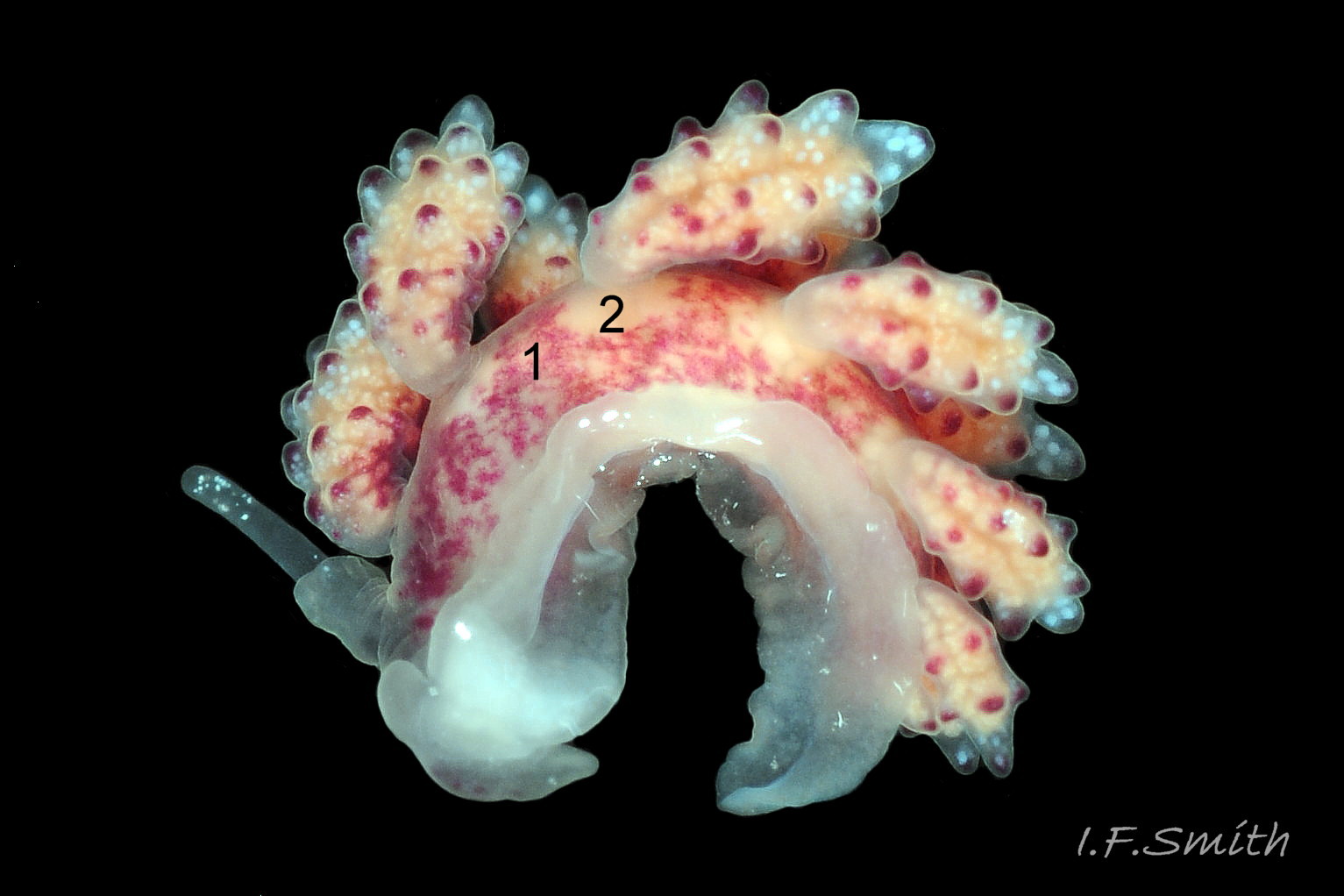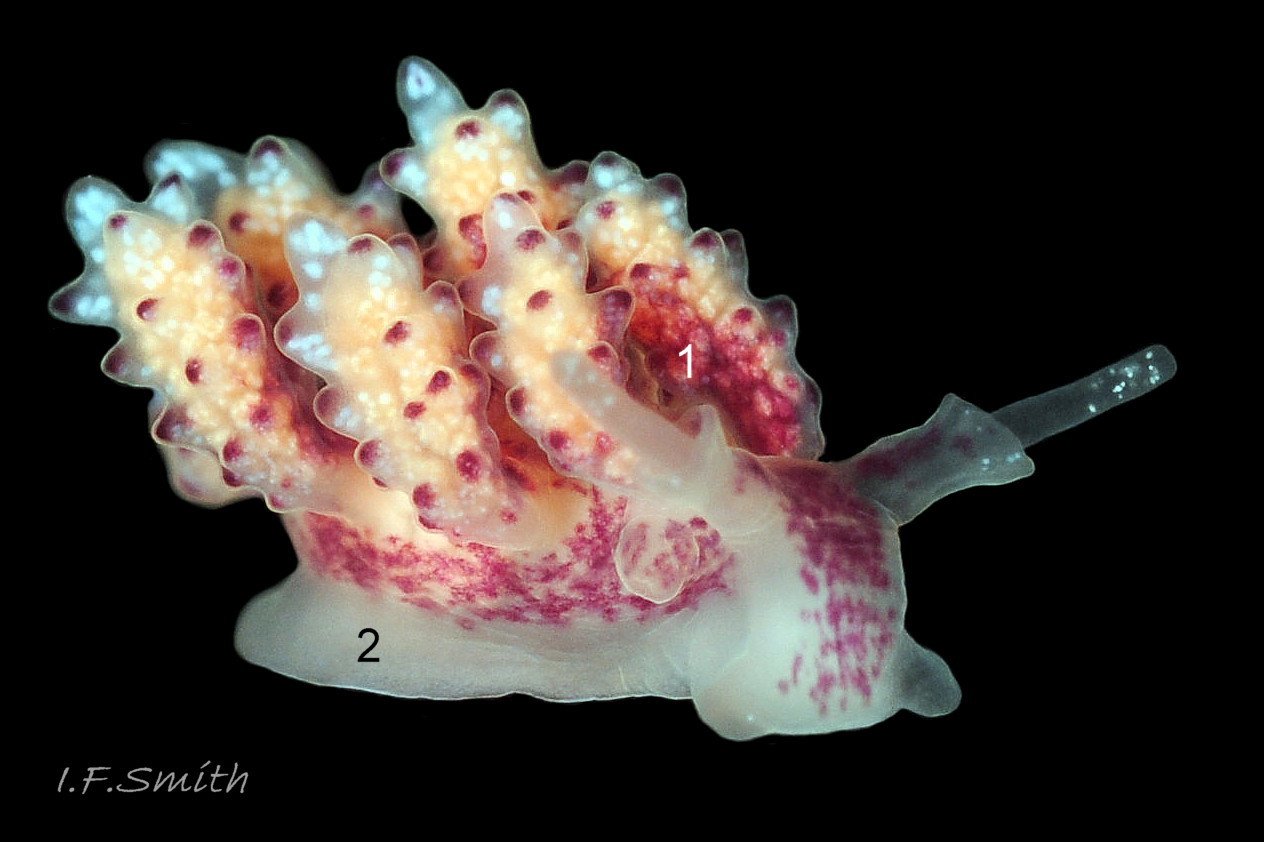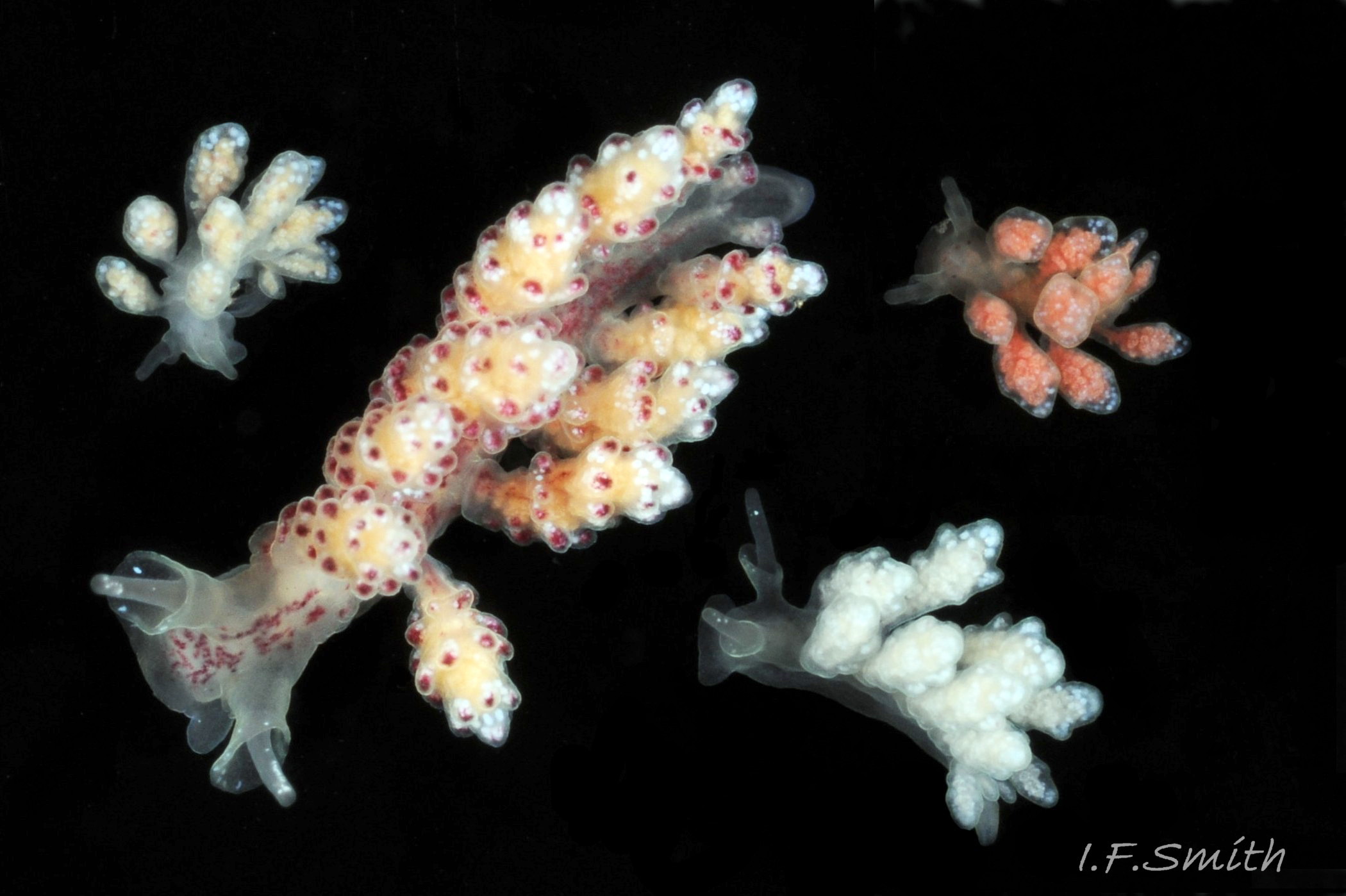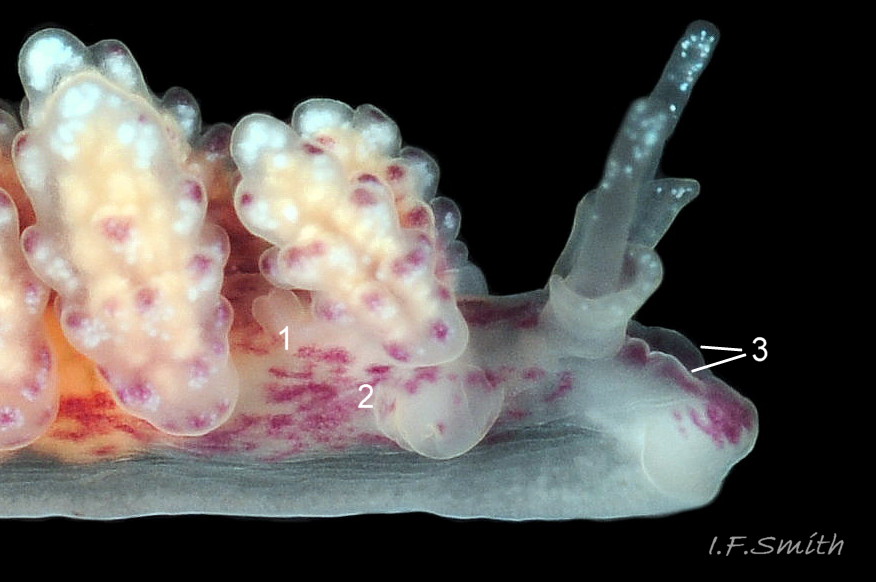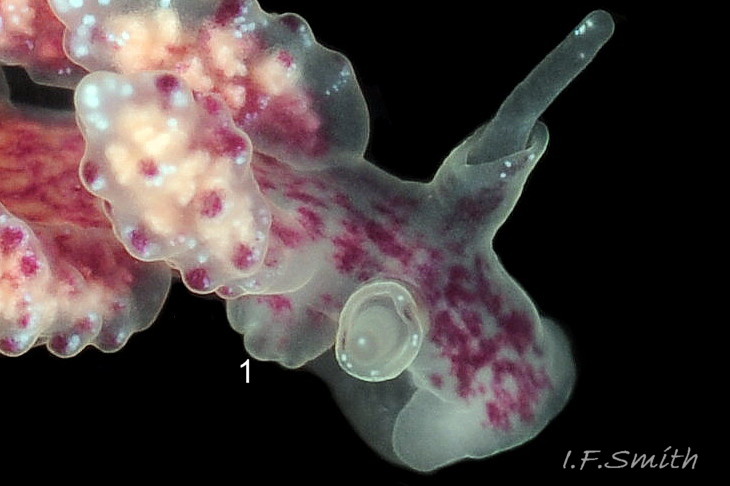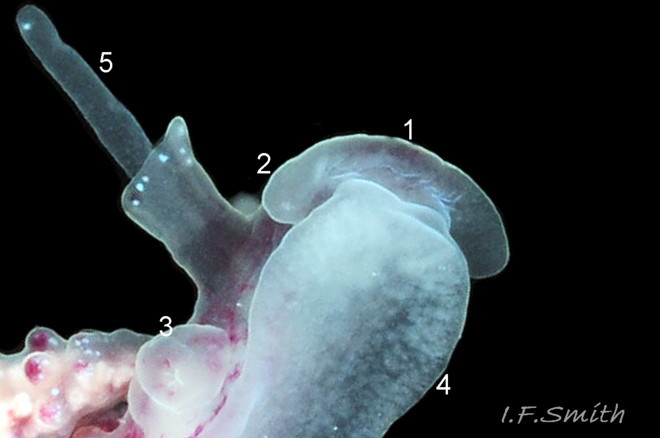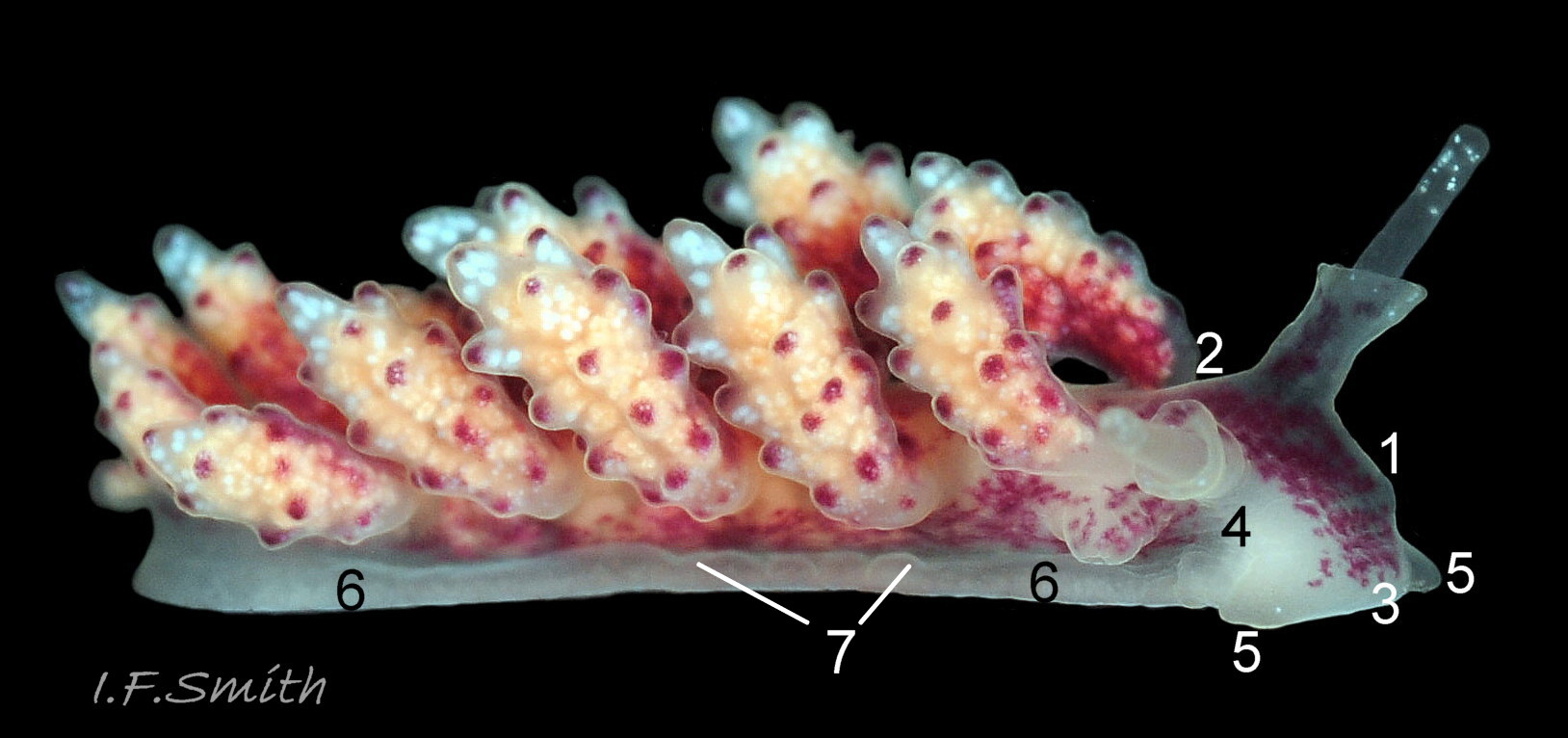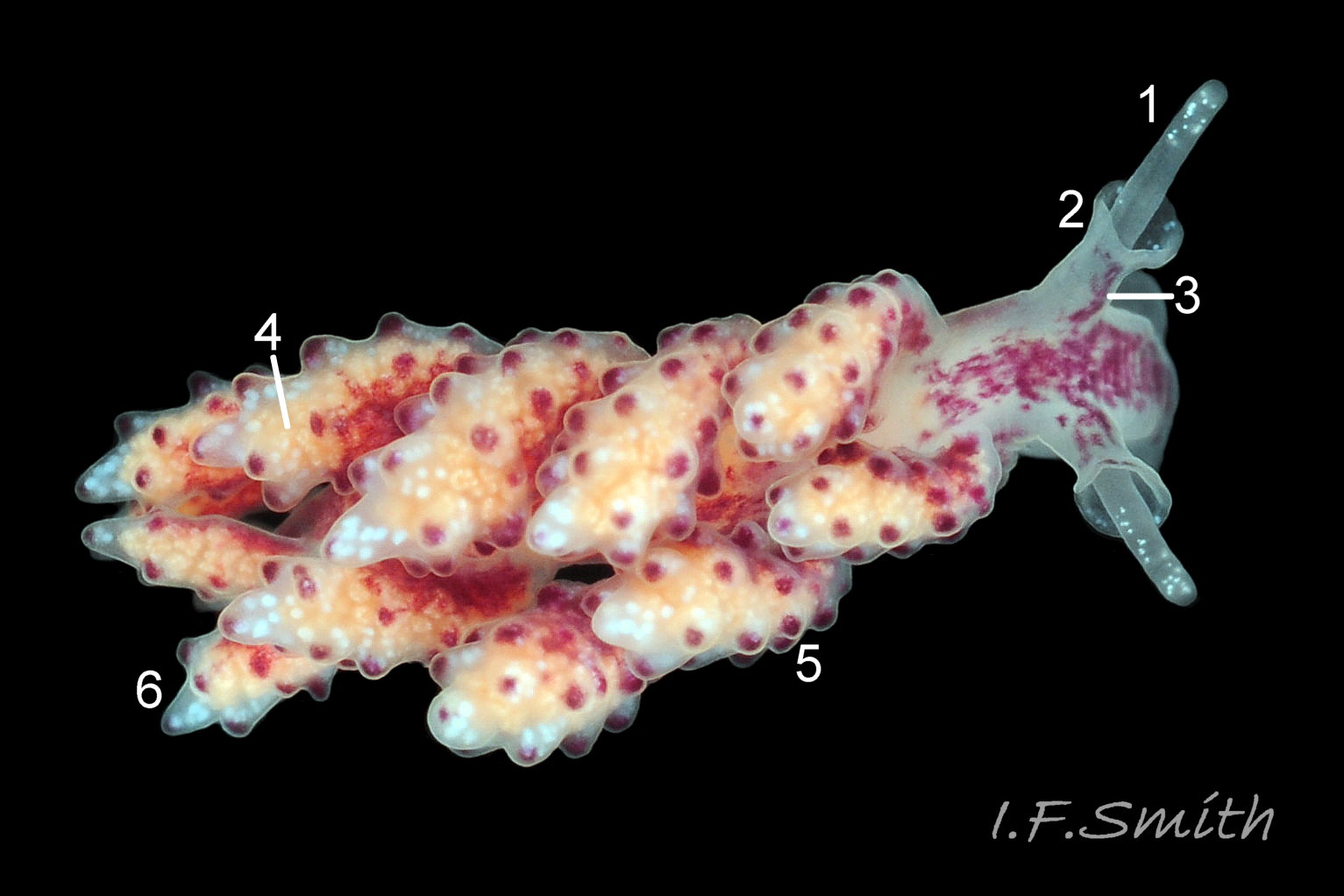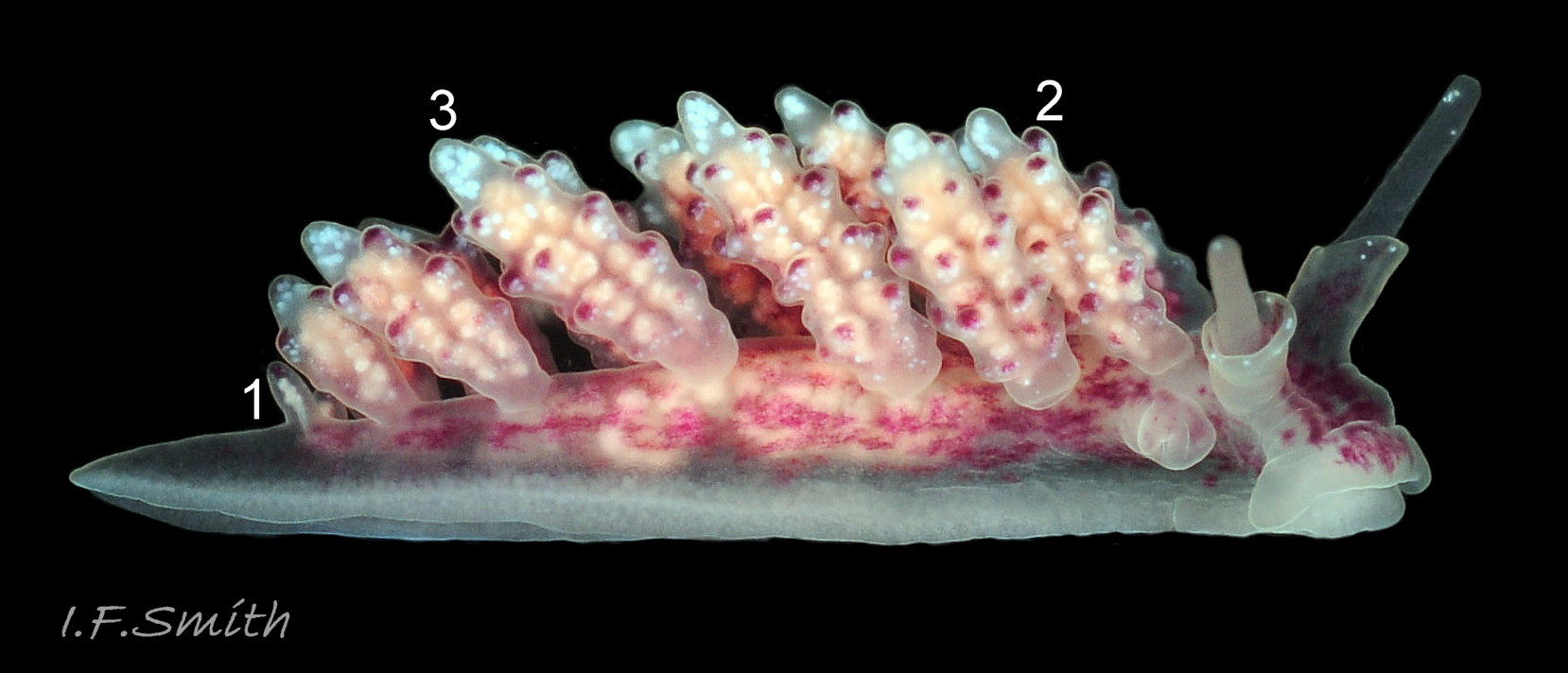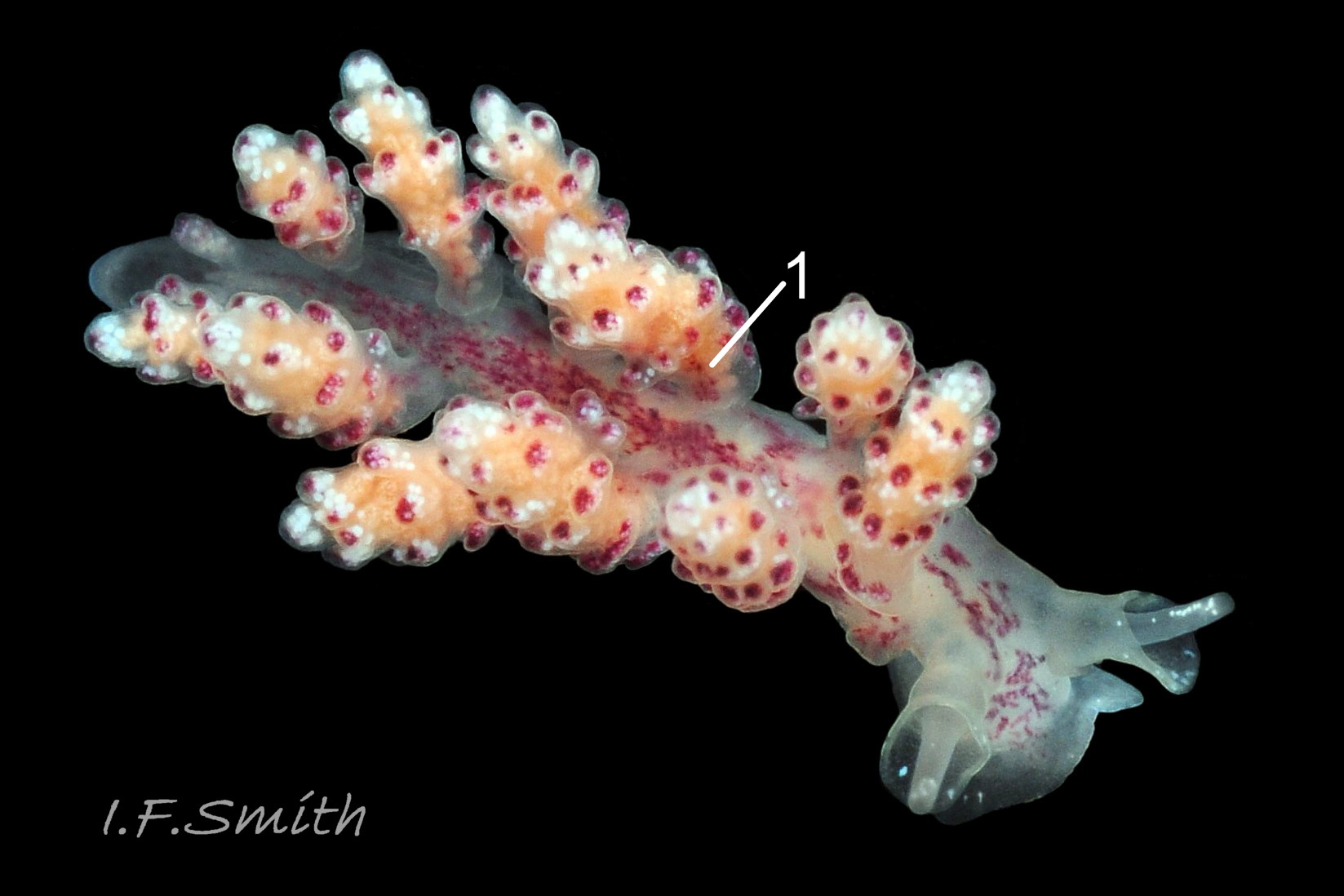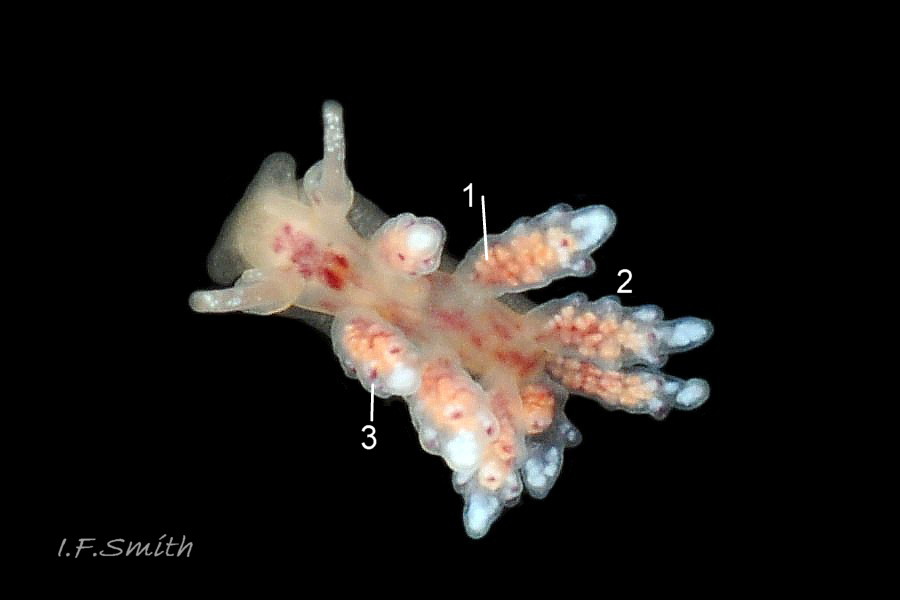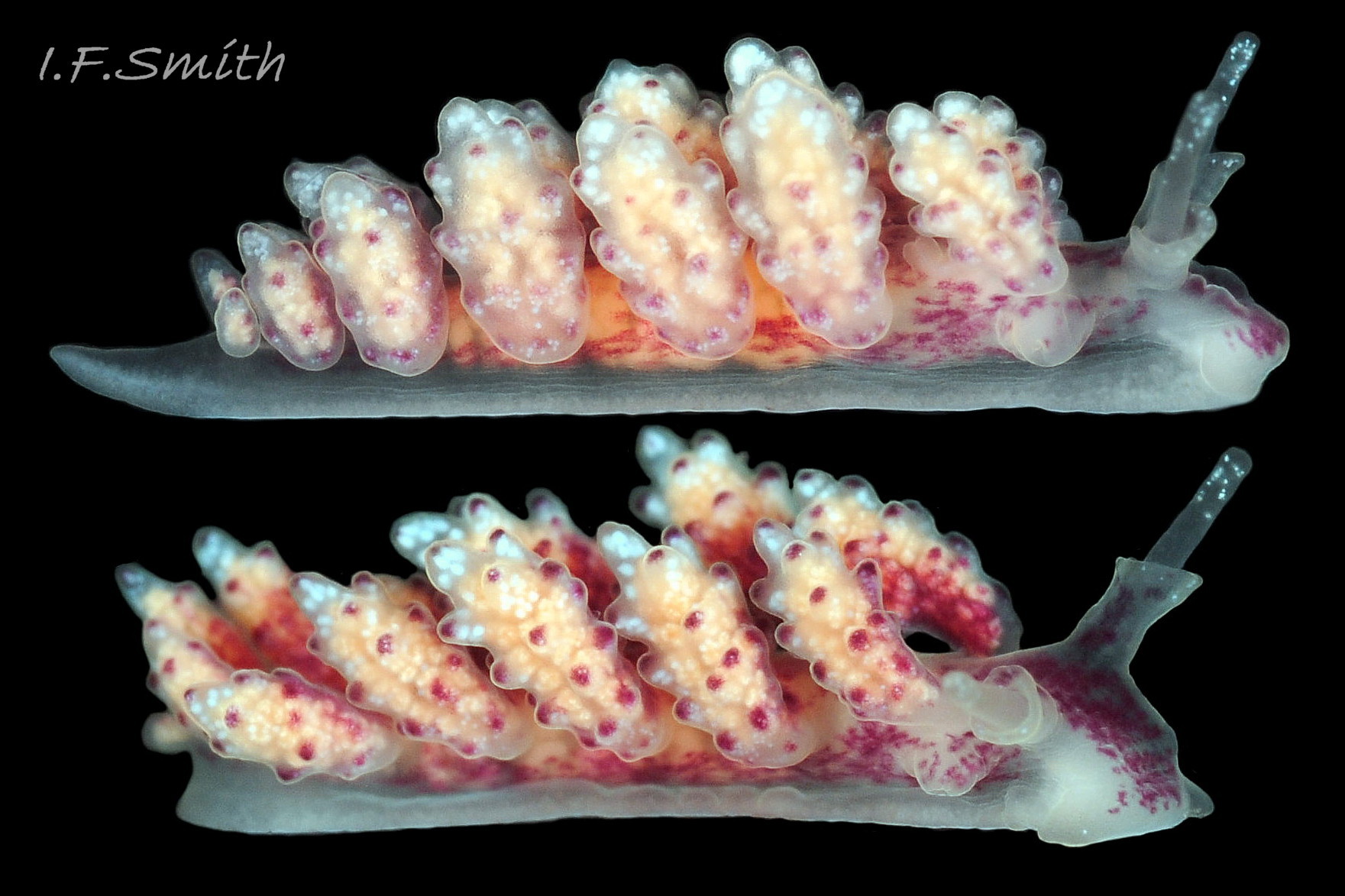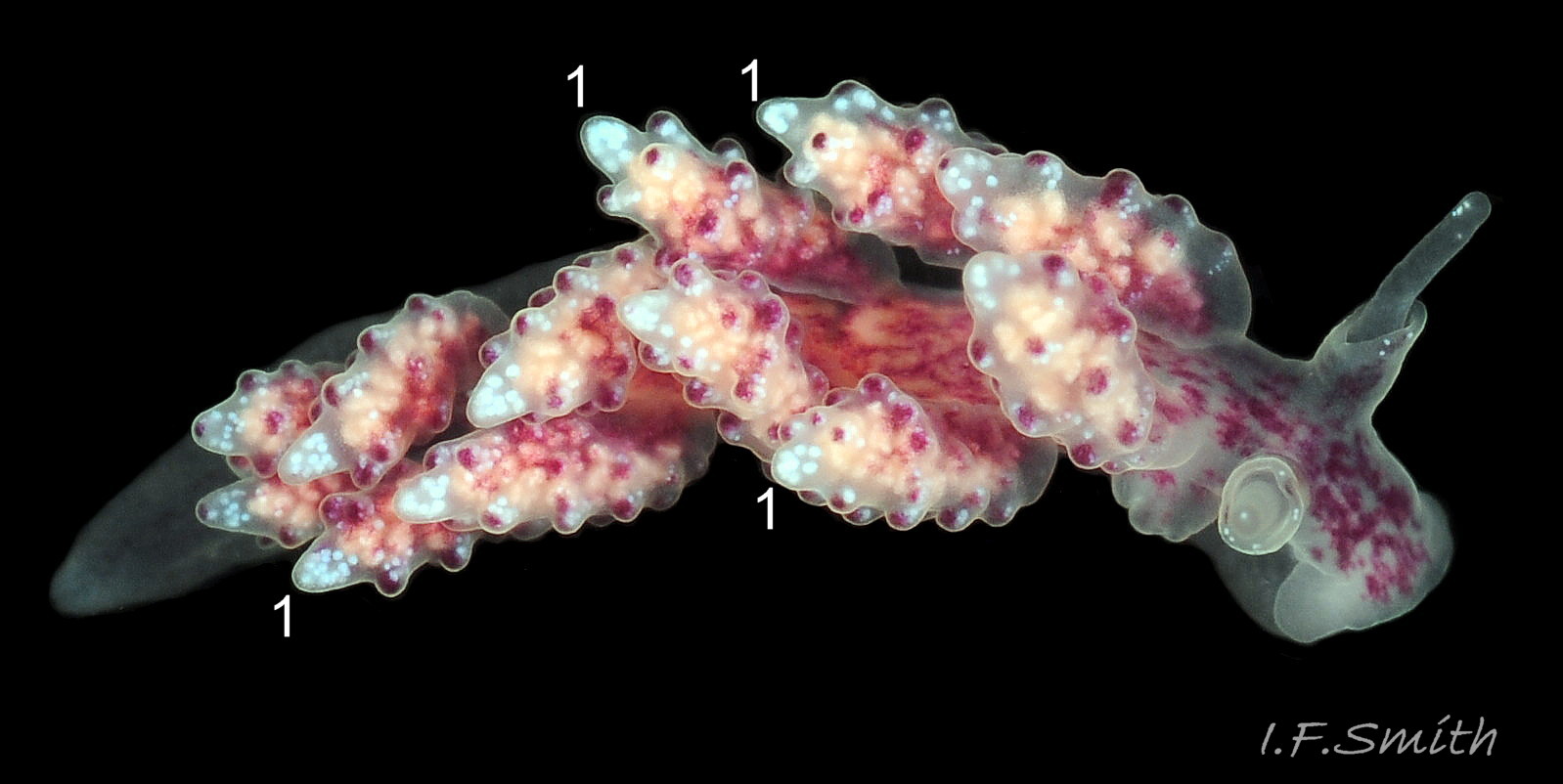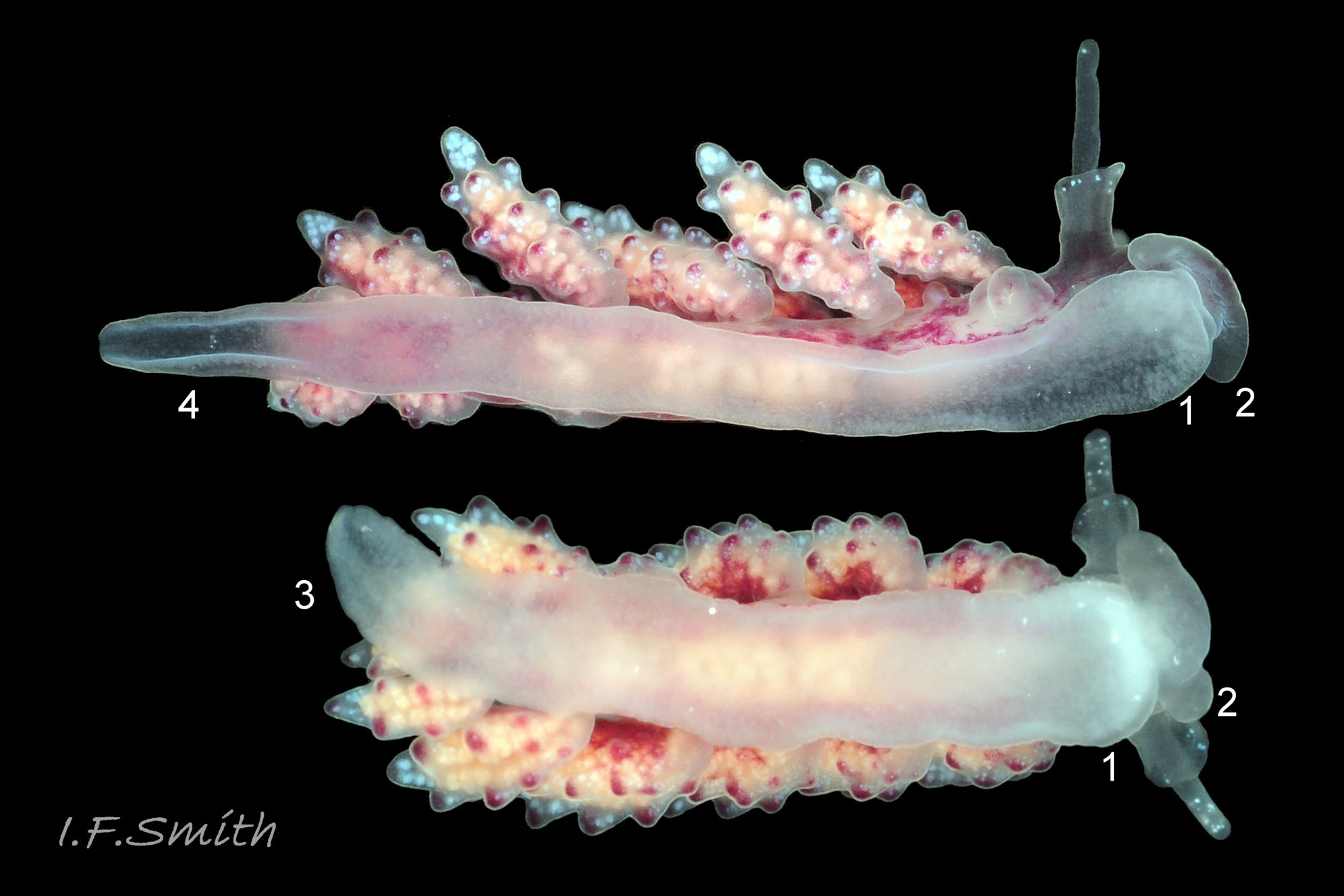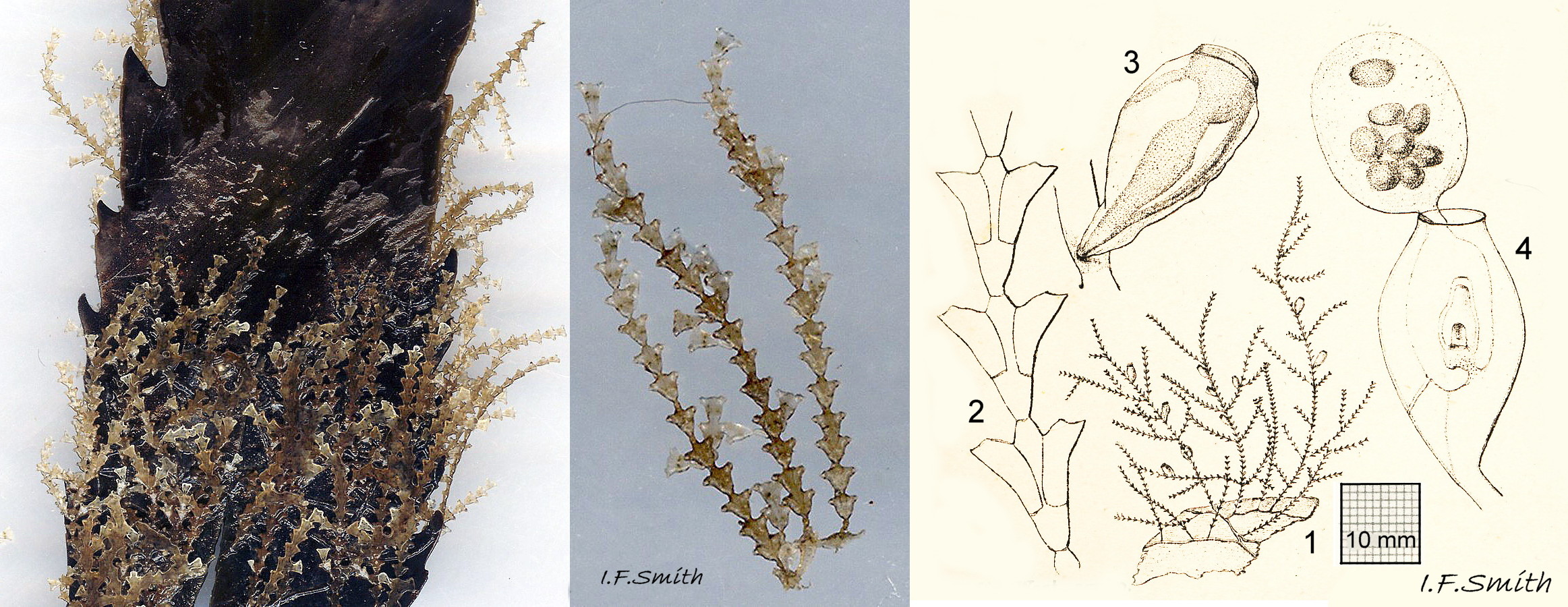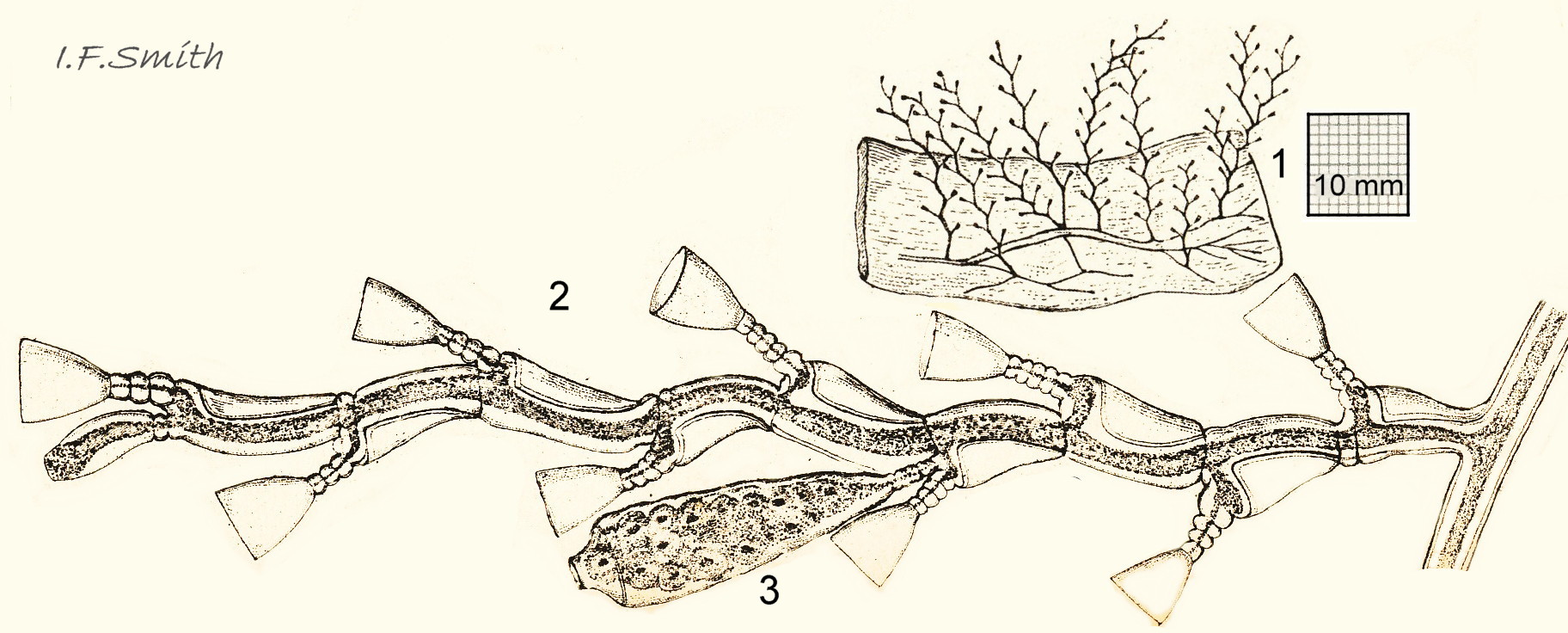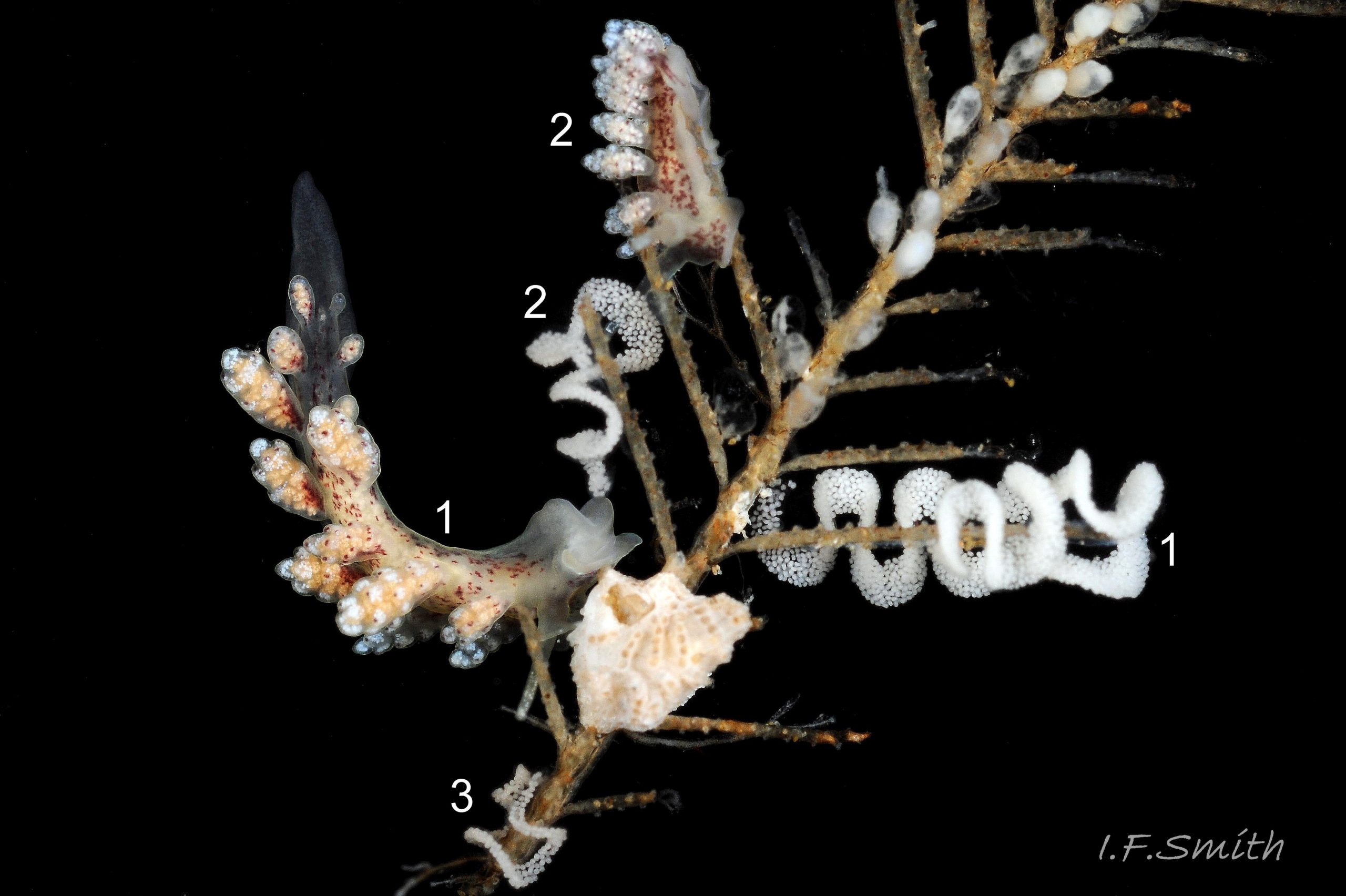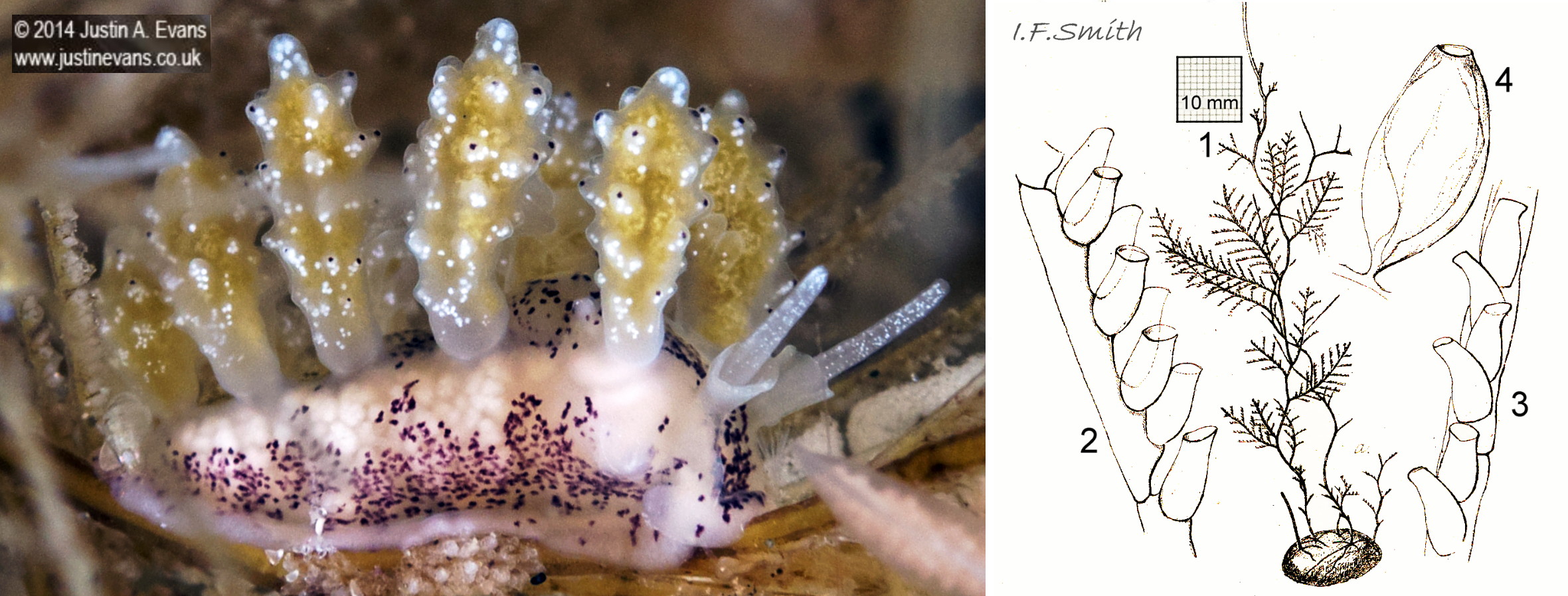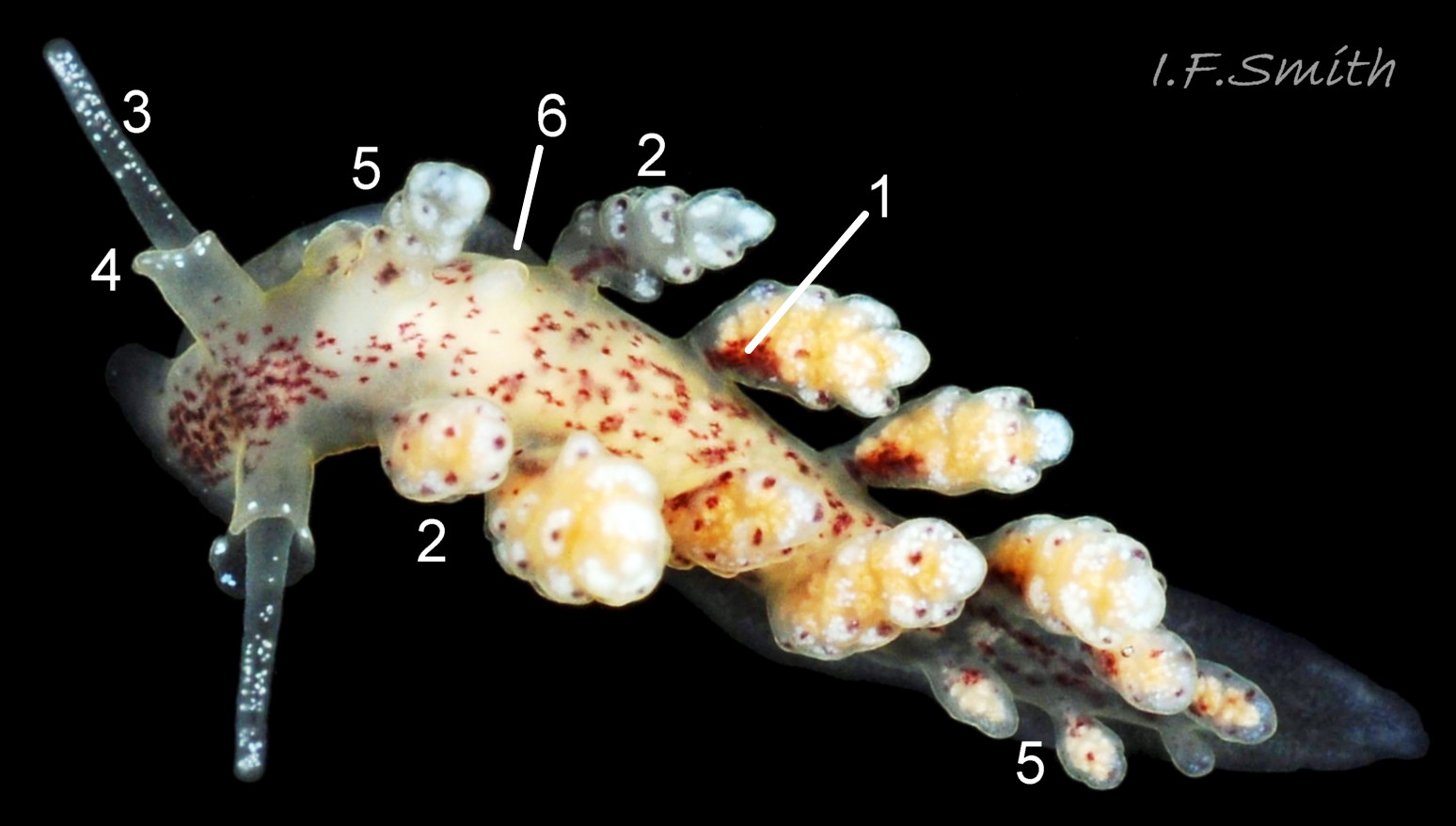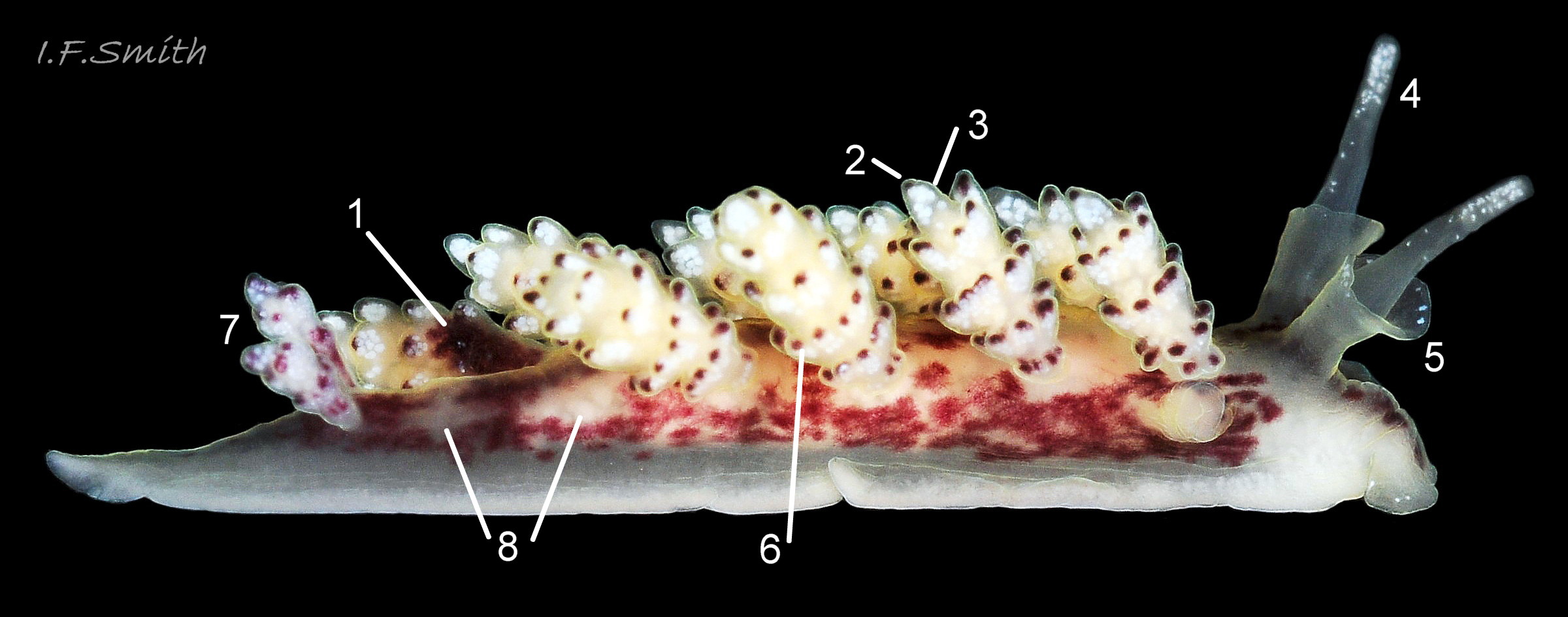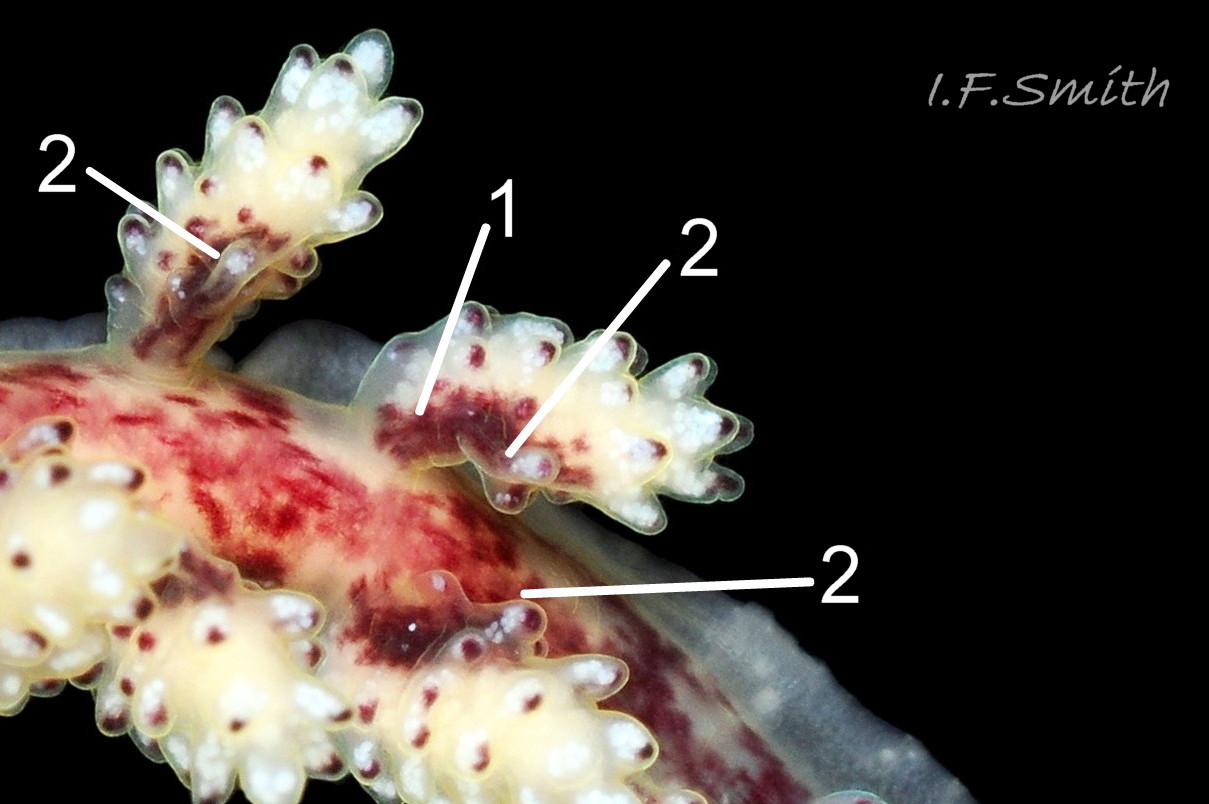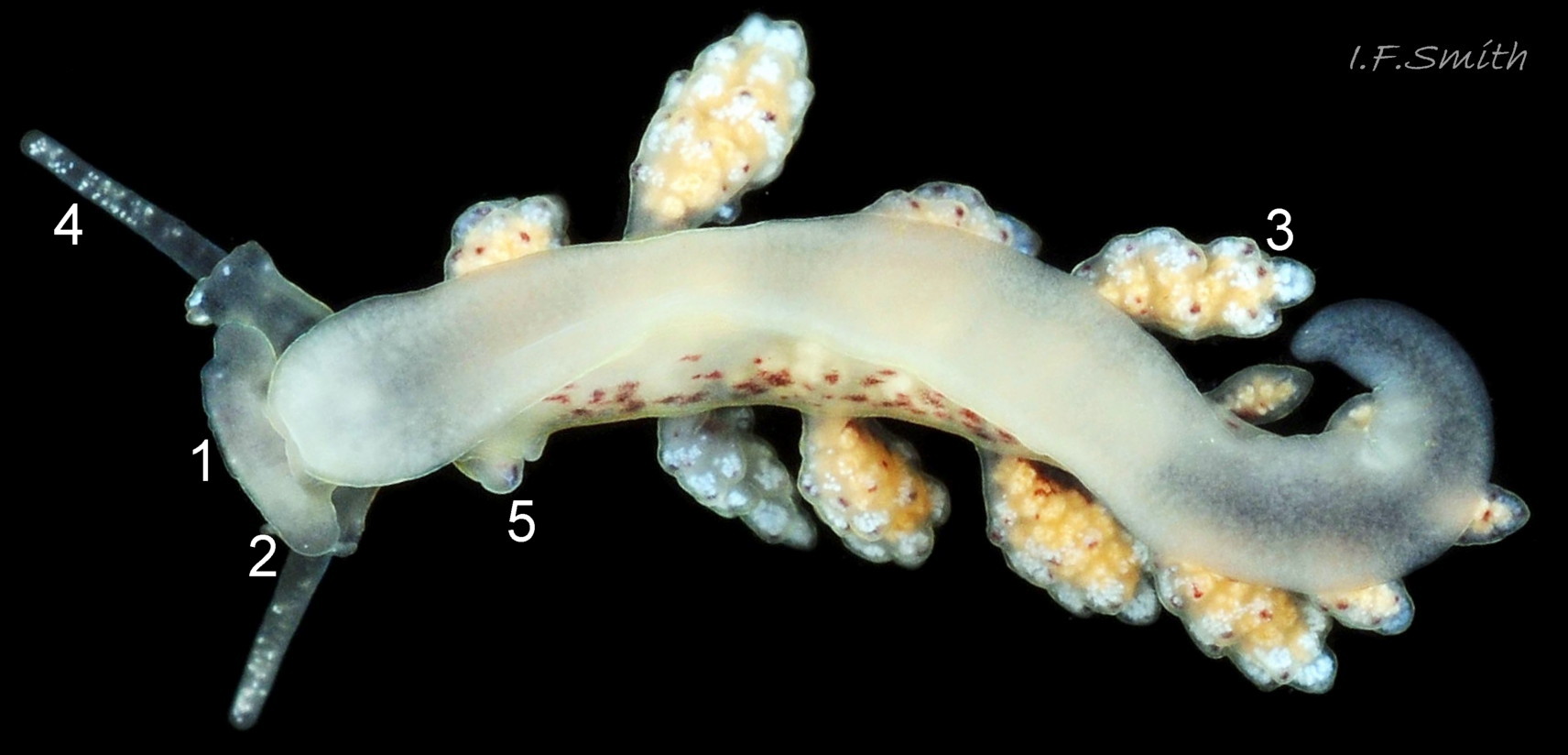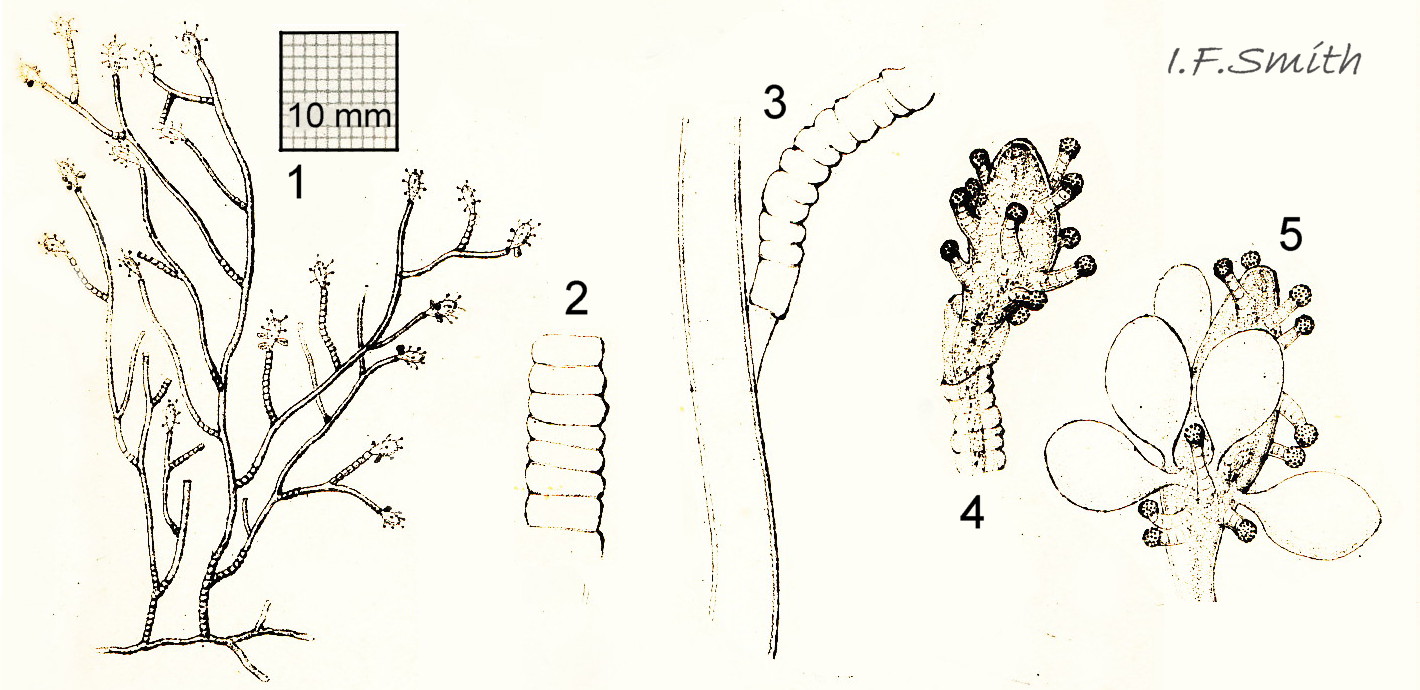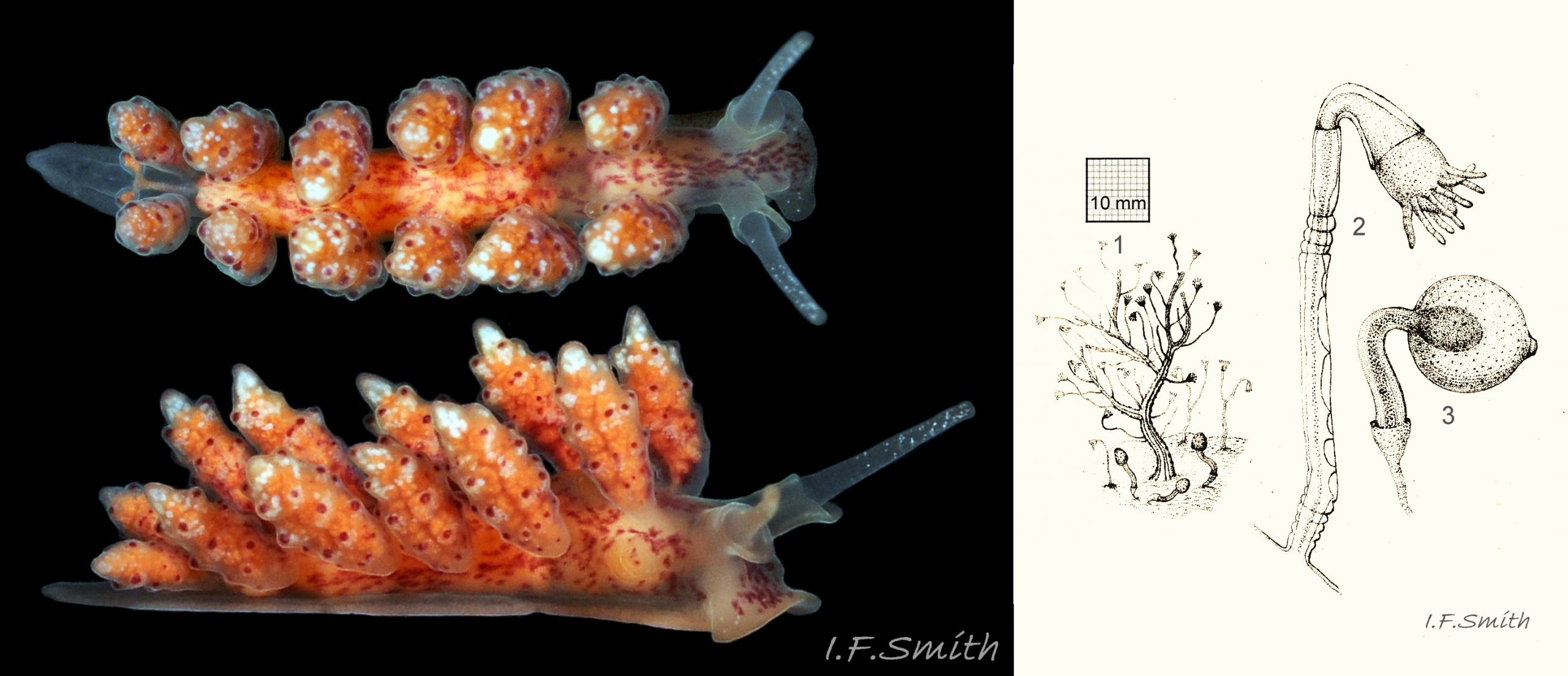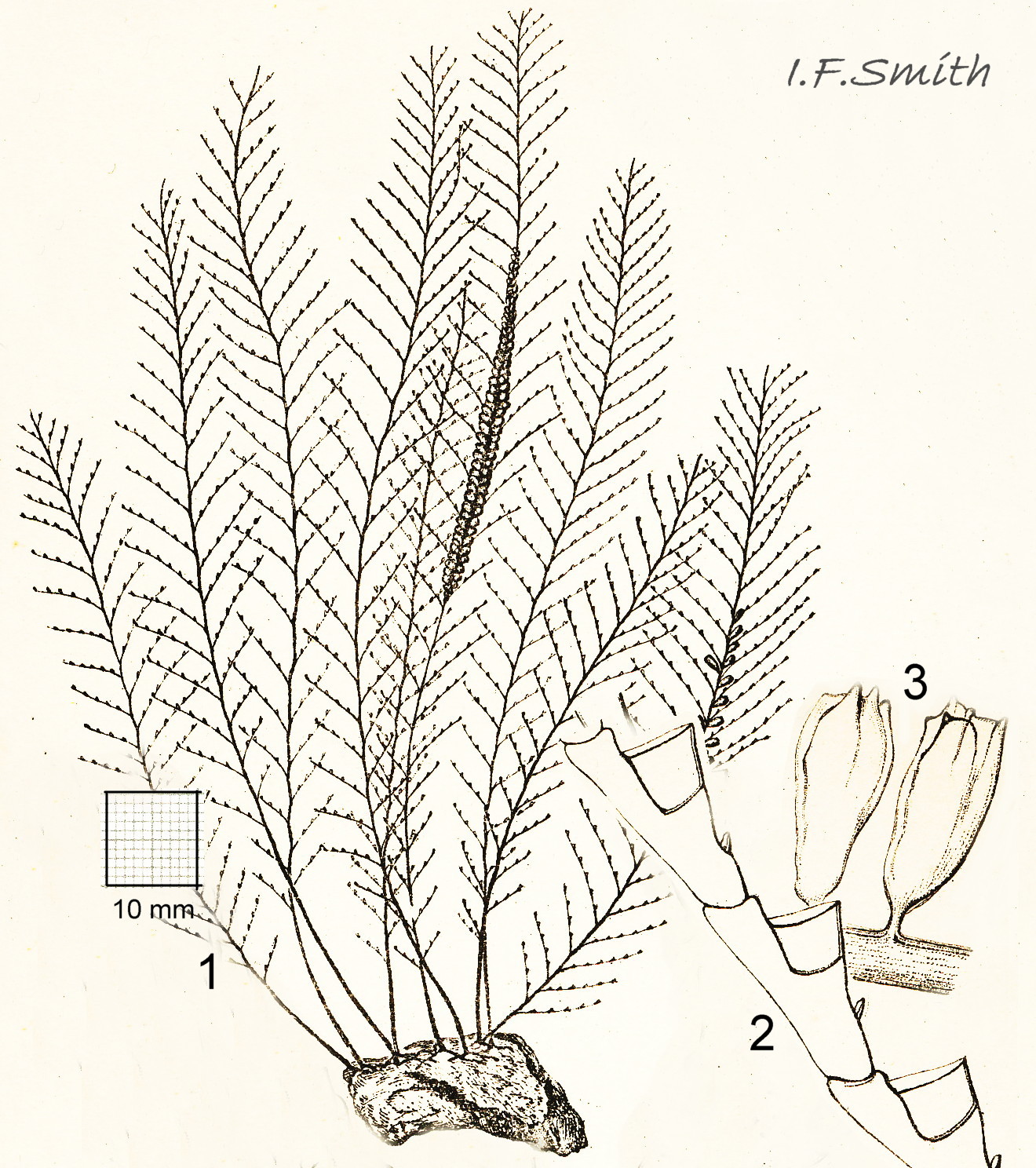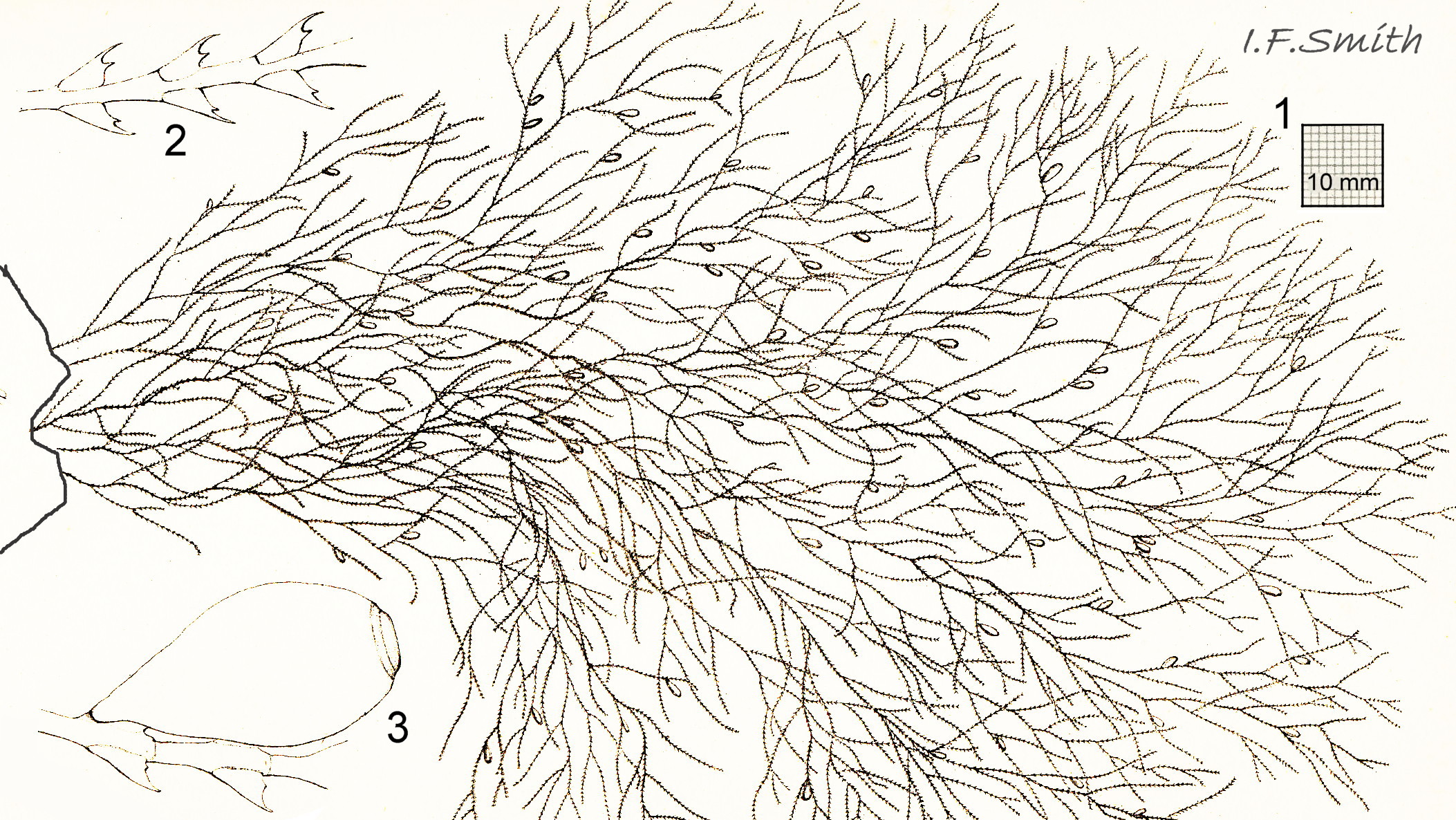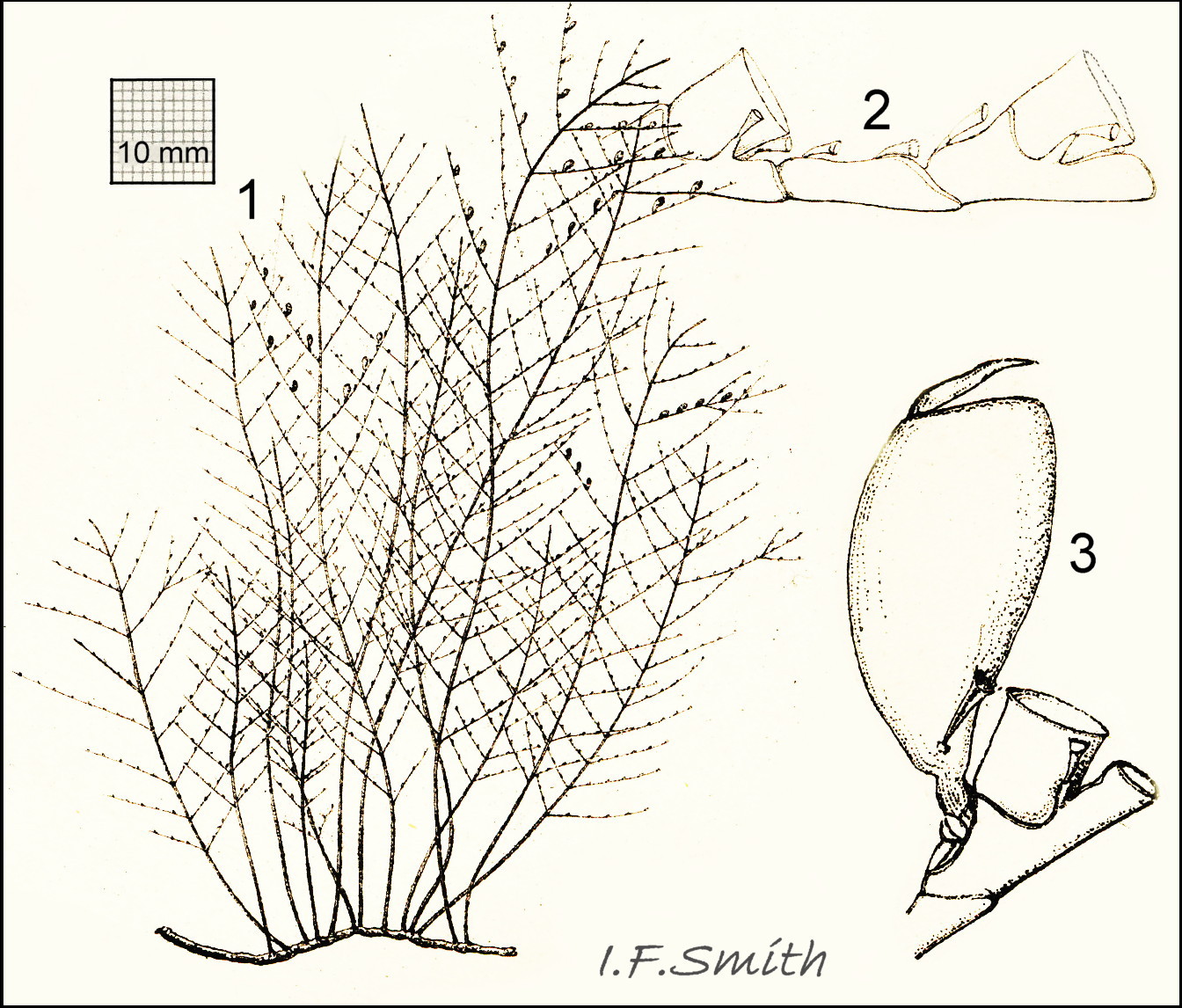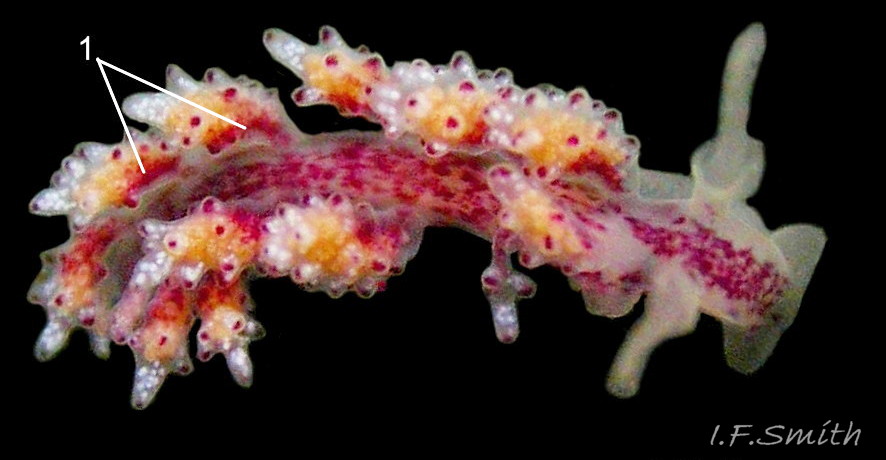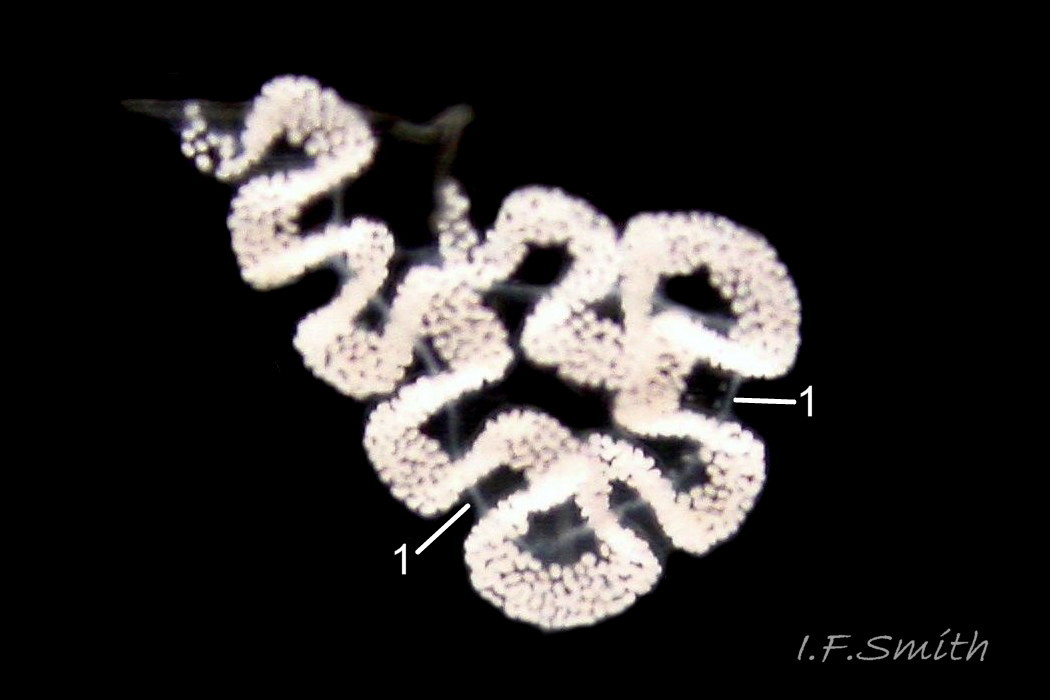Click image to enlarge with full caption. Main text below slider.
Doto coronata Gmelin, 1791
Current taxonomy; World Register of Marine Species
www.marinespecies.org/aphia.php?p=taxdetails&id=139631
Synonyms
D. coronata was formerly an aggregate of species, many of which have now been segregated; seven are listed in ‘Similar Species’ below. It may still have other undescribed species within it.
GLOSSARY BELOW
Body description
Usually up to 12 mm long, exceptionally to 15 mm. Translucent whitish with dorsal blotches and streaks of red surface pigment extending between cerata onto flanks, but not around immediate base of each ceras ( 01 Doto coronata) and not onto upper surface of foot ( 02 Doto coronata). Intensity of markings varies; if not too intense, yellowish spheroids of the ovotestis may be seen through the translucent dorsum within the body of mature individuals ( 03 Doto coronata ). Pigment reduced or absent on juveniles ( 04 Doto coronata). There are a dorsolateral anal papilla between the first and second ceras on the right ( 05 Doto coronata), and a hermaphrodite genital papilla below the first ceras, sometimes with the penis partly extruded ( 06 Doto coronata).
The head has a crescentic oral veil, which extends into lateral flaps when spread ( 07 Doto coronata), but no oral tentacles. A slight head crest runs from in front of each rhinophore to the base of the oral veil ( 05 Doto coronata); but they are often inconspicuous ( 08 Doto coronata); Thompson and Brown (1984) did not detect them, but they were described by Shipman & Gosliner (2015).
Reddish pigment on the dorsal surface of the head extends back between the rhinophores and forwards onto the central part of oral veil, but pigment is usually slight or absent laterally on the head and veil flaps ( 08 Doto coronata). The finger-like, smooth, translucent, white rhinophores have variable amounts of opaque white freckling ( 07 Doto coronata & 09 Doto coronata), mainly in the distal half. Each arises, tilting forwards, from a translucent white basal sheath with a smooth rim which is dilated, particularly at the front. The sheath usually has a few white pigment spots and, sometimes, some reddish pigment ( 09 Doto coronata).
There is a longitudinal row of single cerata on each side of the body. The number of cerata in each row increases with growth to seven or eight
( 04 Doto coronata); the most recent addition, at the posterior, is often small and easily overlooked ( 10 Doto coronata). The size of cerata varies; when they are plump and held over the body, little of the dorsum is exposed ( 09 Doto coronata). Cerata are translucent whitish, revealing the red, orange, white ( 04 Doto coronata) or pink ( 10 Doto coronata) internal digestive gland which extends almost to the apex as there are no cnidosacs. The colour of the digestive gland is influenced by diet; juveniles may feed on hydroid species different from those eaten by adults. The red pigment blotching of the body extends subepidermally into the mesial face of cerata, often reaching half way up or further ( 02 Doto coronata ) on large specimens, but less extensively on small adults ( 11 Doto coronata), and often absent on juveniles ( 12 Doto coronata). Each ceras usually has up to four ( 10 Doto coronata ) rings of rounded b>tubercles, often with an indistinct partially formed fifth ring at the base, and a protruding apical tubercle. Internally, each tubercle usually has an apical reddish spheroid of varying shade and saturation ( 13 Doto coronata) and several sub-apical, white, granular bodies ( 10 Doto coronata). Small juveniles lack well developed tubercles and reddish spheroids ( 04 Doto coronata & 12 Doto coronata ), and some adults have them weakly developed or missing ( 14 Doto coronata). The mesial faces of cerata sometimes have indistinct pseudobranchs.
The foot has a translucent white sole ( 15 Doto coronata), which reveals the yellowish spheroids of the ovotestis in mature individuals.
There are no propodial tentacles but, from above, the flaps of the oral veil might be mistaken for tentacles. The upper surface of the foot is translucent white with no reddish pigment. ( 02 Doto coronata ). The foot can spread wide to crawl on flat surfaces, or curl into a deep gutter to grip round the stem of hydroid prey ( 15 Doto coronata ).
Key identification features
1: oligophage, reported to feed on a range of hydroid species, including Dynamena pumila ( 16 Doto coronata), Obelia dichotoma ( 17 Doto coronata), Obelia geniculata ( 18 Doto coronata) and Sertularia cupressina ( 19 Doto coronata. ).
2: red pigment extends half way up mesial face of cerata on large adults ( 02 Doto coronata); “the most distinguishable characteristic of D. coronata” (Shipman & Gosliner, 2015) but pigment is less or absent on juveniles ( 12 Doto coronata) and see D. hydrallmaniae in ‘similar species’, below. Unless a juvenile is on an appropriate food hydroid, its identification is usually unreliable.
3: usually each ceras has up to four concentric rings of rounded tubercles, often with an indistinct partially formed fifth ring at base, ( 10 Doto coronata ); tubercles may be absent on juveniles.
4: each tubercle has a red spheroid and several white granular bodies on adults ( 10 Doto coronata).
5: pseudobranchs indistinct or absent.
Similar species
Specimens identified in the past as D. coronata are in a complex of species that have since been segregated with molecular methods. Some unrecognised species in the complex probably remain to be discovered.
“Morrow et al. discovered D. hydrallmaniae and D. sarsiae with the use of morphology, early molecular methods, and hydroid prey. — – The relationships of D. eireana, D. sarsiae, and D.hydrallmaniae to the true D. coronata also require further investigation since D. eireana’s relationship within the complex clade is unresolved and D. sarsiae and D. hydrallmaniae were not incorporated [in the Shipman & Gosliner study] owing to the absence of appropriately preserved material.” (Shipman & Gosliner, 2015).
Few recorders feel able to confidently identify D. eireana, D. sarsiae, D. hydrallmaniae and some other segregates by morphology alone, so identifications usually rely on the species of hydroid they are found on. This can lead to misidentification unless feeding, rather than mere presence, is observed. Seaslugs are often most easily noticed when displaced from their usual prey on which they are well camouflaged. Some consumed hydroids are small, unobtrusive species which live epizoically on larger hydroids, leading the latter to be mistakenly assumed to be the prey. Knowledge of which slug species feed on which hydroid species is incomplete. Assumed monophages may subsequently be found to be oligophages like D. coronata, which feeds on some hydroid species used by monophages. Collaborating identification evidence, such as morphology, should be used in addition to species of prey.
With the exception of some D. hydrallmaniae, none of the following segregates have reddish pigment on the mesial faces of their cerata resembling that on D. coronata. Links in the list are to on-line images and information in Picton, B.E. & Morrow, C.C., 2016. Encyclopedia of Marine Life of Britain and Ireland.
D. hydrallmaniae Morrow, Thorpe & Picton, 1992.
www.habitas.org.uk/marinelife/species.asp?item=W12795
1: monophage, feeds exclusively on Hydrallmania falcata ( 20 Doto coronata, 21 Doto coronata and
www.habitas.org.uk/marinelife/species.asp?item=D6530 ).
2: subepidermal, dark brown-red pigment on lower part of mesial face of cerata ( 22 Doto coronata) on many, but not all ( 21 Doto coronata) adults (so red mesial face pigment is not unique to D. coronata).
3: typically 5 or 6 rings of tubercles on the larger cerata, with up to 9 tubercles in the third ring from the top. ( 23 Doto coronata).
4: dark red spheroid and several white granular bodies in each tubercle on adults ( 22 Doto coronata & 21 Doto coronata).
5: tips of the large pseudobranchs reach the third ring of tubercles from the top of the ceras and have a dark red spheroid like that of the tubercles ( 24 Doto coronata. ).
6: oral veil rectangular with broad lateral flaps (5 25 Doto coronata).
Red pigment extending up to half way up the mesial face of cerata [on adults] is “the most distinguishable characteristic of D. coronata” (Shipman & Gosliner, 2015). D. hydrallmaniae is an exception to this is with “dark red marks on the inner faces of the cerata” (Morrow et al., 1992) on most specimens, though not the one in .
D. sarsiae Morrow, Thorpe & Picton, 1992. www.habitas.org.uk/marinelife/species.asp?item=W12885
Feeds on Coryne eximia ( 26 Doto coronata and
www.habitas.org.uk/marinelife/species.asp?item=D1700 ).
Specimens which might be D. sarsiae were found on Garveia nutans ( 27 Doto coronata and www.habitas.org.uk/marinelife/species.asp?item=D3180 ), but they did not exactly fit the description of D. sarsiae as, apart from their prey differing, their cerata had high apical tubercles, many or all of which contained no reddish spheroid.
D. dunnei Lemche, 1976.
www.habitas.org.uk/marinelife/species.asp?item=W12770 Genetically very close to D. millbayana, might be conspecific (Shipman & Gosliner, 2015).
Feeds on Kirchenpaueria pinnata ( 28 Doto coronata and www.habitas.org.uk/marinelife/species.asp?item=D5850 ).
D. eireana Lemche, 1976. www.habitas.org.uk/marinelife/species.asp?item=W12780
Feeds on Amphisbetia operculata ( 29 Doto coronata and www.habitas.org.uk/marinelife/species.asp?item=D6320 ).
D. koenneckeri Lemche, 1976. www.habitas.org.uk/marinelife/species.asp?item=W12810
Feeds on Aglaophenia pluma ( 30 Doto coronata and
www.habitas.org.uk/marinelife/species.asp?item=D5540 ).
D. maculata (Montagu, 1804).
www.habitas.org.uk/marinelife/species.asp?item=W12830
Feeds on Halopteris catharina ( 31 Doto coronata and
www.habitas.org.uk/marinelife/species.asp?item=D5780 ).
D. millbayana Lemche, 1976.
www.habitas.org.uk/marinelife/species.asp?item=W12840 Genetically very close to D. dunnei, might be conspecific (Shipman & Gosliner, 2015).
Feeds on Plumularia setacea which often grows on larger hydroids. ( 32 Doto coronata and
www.habitas.org.uk/marinelife/species.asp?item=D6050 ).
Habits and ecology
D. coronata lives on the lower shore and sublittoral on hard substrate with hydroids. It is a generalist feeder (Shipman & Gosliner, 2015) and has been reported from a wide range of hydroids, but some records were of species now segregated from D. coronata. Specimens with D.N.A. conforming to that of the neotype established by Shipman & Gosliner (2015) were obtained by them from Obelia dichotoma ( 17 Doto coronata and www.habitas.org.uk/marinelife/species.asp?item=D7300 ), Obelia geniculata ( 18 Doto coronata. and www.habitas.org.uk/marinelife/species.asp?item=D7310 ),
and Sertularia cupressina ( 19 Doto coronata). Intertidally, I have found numerous specimens on Dynamena pumila ( 16 Doto coronata) that morphologically match the redescription of D. coronata by Shipman & Gosliner (2015) ( 33 Doto coronata). Lemche (1985, in Picton & Morrow 2016) opined that D. onusta Hesse, 1872 specializes on Dynamena pumila, but none of the Doto specimens that I found on it had the black markings described by Hesse or illustrated tentatively at www.habitas.org.uk/marinelife/species.asp?item=W12860 . Dotidae differ from Aeolidiidae in avoiding the polyps of hydroids containing the stinging nematocysts by puncturing the stalks and sucking out the contents. Consequently, they have no need for cnidosacs to store ingested nematocysts.
D. coronata is a simultaneous hermaphrodite. It matures sexually at a small size; spawn masses vary with the size of the animal. The spawn is a white or pinkish-white band crimped into a regular Greek key pattern; a thin, adhesive line of mucus appears to hold the crimps in position ( 34 Doto coronata). It breeds in most months, with up to four generations per year. Shelled veligers live in the plankton before transforming into adults.
Distribution and status
D. coronata is found from Iceland and Spitzbergen to the Mediterranean, and in New England, USA. Records from South Africa are another species (Shipman & Gosliner, 2015), GBIF map www.gbif.org/species/5190041 . It is widespread and often common in Britain and Ireland, but many records are of species now segregated from D. coronata sensu lato or are species yet to be recognised. UK map species.nbnatlas.org/species/NBNSYS0000175014
Acknowledgement
I thank Justin Evans of www.justinevans.co.uk for use of his image of Doto hydrallmaniae.
References & links
Alder, J. & Hancock, A. 1845-1855. A monograph of the British nudibranchiate mollusca. London, Ray Society.
www.biodiversitylibrary.org/bibliography/65015#/summary
Index, old nomenclature; most listed in genus Eolis or Doris, at www.biodiversitylibrary.org/page/41958183#page/551/mode/1up .
Hesse, H. 1872. Diagnoses de nudibranches nouveaux des côtes de Bretagne. Journal de Conchyliologie. 20: 345-348.
www.biodiversitylibrary.org/page/15684555#page/352/mode/1up .
Hincks, T. 1868. A history of the British hydroid zoophytes vol. 1 & 2. London, Van Voorst.
www.biodiversitylibrary.org/item/16848#page/7/mode/1up .
Morrow, C.C., Thorpe, J.P. & Picton, B.E. 1992. Genetic divergence and cryptic speciation in two morphs of the common subtidal nudibranch Doto coronata (Opisthobranchia: Dendronota: Dotoidae) from the northern Irish Sea. Mar. Ecol. Prog. Ser. 84: 53 to 61. www.int-res.com/articles/meps/84/m084p053.pdf? .
Picton, B.E. & Morrow, C.C. 2016. Encyclopedia of Marine Life of Britain and Ireland www.habitas.org.uk/marinelife/species.asp?item=W12740
Shipman, C. & Gosliner, T. 2015. Molecular and morphological systematics of Doto Oken,1851 (Gastropoda: Heterobranchia), with descriptions of five new species and a new genus. Zootaxa 3973 (1): 057 to101.
www.researchgate.net/publication/278374256_Molecular_and_…
Thompson, T.E. & Brown, G.H. 1984. Biology of opisthobranch molluscs 2. London, Ray Society.
Current taxonomy; World Register of Marine Species
www.marinespecies.org/aphia.php?p=taxdetails&id=139631
GLOSSARY
anal papilla = small nipplelike protruberance bearing anus.
cerata = (sing. ceras) lobes on dorsum of Aeolidiidae and some other seaslugs, including Dotidae.
cnidaria = hydroids, jellyfish, sea anemones etc.
cnidosac = storage capsule at tips of cerata of Aeolidiidae, but not Dotidae, for ingested unexploded nematocysts.
dorsolateral = at or near junction/merging of dorsal and lateral surfaces.
epizoic = living on the exterior of another living animal.
gastrozooid = feeding polyp of a hydroid.
genital papilla = nipplelike protruberance bearing genital opening.
gonotheca = chitinous receptacle in which gonozooids are produced on a hydroid.
gonozooid = reproductive polyp of a hydroid.
head crest (on Doto) = raised rib from front of rhinophore to anterior edge of head.
hermaphrodite, simultaneous = individual acts as both male and female at the same time with similar partner(s).
hydroid = cnidarian with a stem and, often, branches bearing a colony of gastrozooids (feeding polyps) and gonozooids (reproductive polyps).
hydrotheca = chitinous receptacle containing a gastrozooid on a hydroid. monophage = an animal which feeds exclusively on a single prey species.
mesial = on or facing towards the midline of the body.
nematocysts = explosive stinging cells of hydroids, jellyfish, sea anemones etc.
oligophage = an animal which feeds on a restricted number of species.
oral tentacles = pair of tentacles on or near anterior edge of head near mouth.
oral veil = flat anterior extension of head.
ovotestis = hermaphrodite organ serving as both ovary and testis.
plankton = animals and plants that drift in pelagic zone (main body of water).
pseudobranch = (on Doto)feature located at base of mesial faces of cerata; definition and function uncertain. May be rudimentary and indistinct , irregularly shaped, bifurcating, finger-like or fan-shaped, and sometimes tipped with a red spot.
rhinophore = chemo-receptor tentacle; nudibranch sea slugs have a pair on top of head.
sensu lato = (abbreviation s.l.) in the wide sense, possibly an aggregate of more than one species.
sensu stricto = (abbreviation s.s.) in the strict sense, excluding species that have been aggregated or confused with it.
subepidermal = below surface of skin.
veliger = shelled larva of marine gastropod or bivalve mollusc which swims by beating cilia of a velum (bilobed flap). Stage may be passed in plankton or within liquid-filled egg-capsule.
